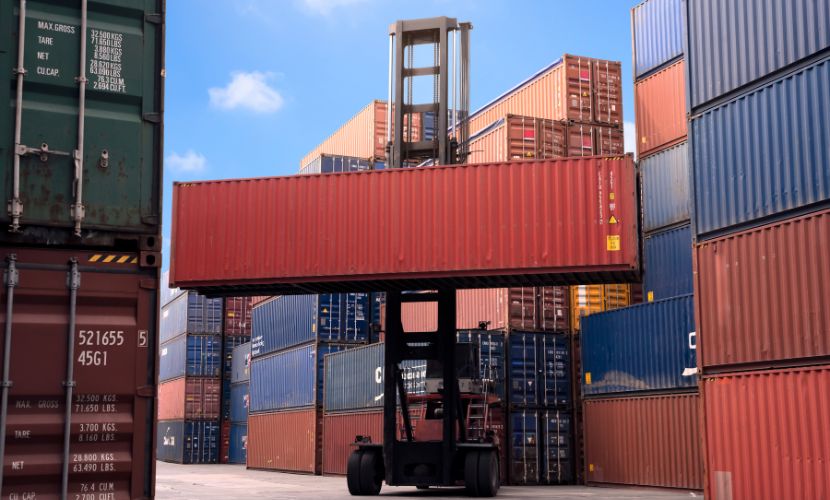The global reach stacker market reached a value of approximately USD 2.59 billion in 2023. Reach stackers are crucial in port, rail, and intermodal operations for handling containers efficiently. These versatile machines offer high stacking capacity and excellent maneuverability, making them indispensable for freight handling and logistics. The market's growth is driven by increasing global trade, expanding containerization, and the need for efficient cargo handling solutions. With technological advancements and the adoption of automation in logistics, the reach stacker market is poised for significant growth, projected to reach USD 4.16 billion by 2032, growing at a CAGR of 5.40% from 2024 to 2032.
Reach Stacker Market Dynamics
The reach stacker market is influenced by several dynamic factors. Key drivers include the rise in global trade activities and the expansion of port infrastructure to accommodate larger volumes of cargo. Additionally, the shift towards automation and digitalization in logistics operations is propelling the demand for advanced reach stackers. However, the market faces challenges such as high initial investment costs and stringent environmental regulations regarding emissions from heavy machinery. Opportunities lie in developing eco-friendly and technologically advanced reach stackers, which cater to the growing demand for sustainable and efficient cargo handling solutions.
Reach Stacker Market Trends
Several trends are shaping the reach stacker market. Firstly, there's a growing focus on incorporating advanced technologies such as IoT and AI for enhanced operational efficiency and real-time monitoring. Secondly, the market is witnessing a shift towards electric and hybrid reach stackers as part of the broader trend of sustainability and reducing carbon footprints. Additionally, modular and customizable reach stacker designs are gaining popularity to cater to specific customer needs. Lastly, the integration of telematics and fleet management systems is becoming standard, offering improved maintenance, reduced downtime, and optimized fleet utilization.
Reach Stacker Market Segmentation
- By Type:
- Empty Container Handlers: Used primarily for handling empty containers, these are lighter and more economical.
- Loaded Container Handlers: Designed to handle fully loaded containers, they offer higher lifting capacity and robustness.
- By Propulsion Type:
- Diesel Reach Stackers: Traditional and widely used, known for their powerful performance.
- Electric Reach Stackers: Growing in popularity due to their environmental benefits and lower operating costs.
- Hybrid Reach Stackers: Combining diesel and electric power, offering a balance between performance and sustainability.
- By Application:
- Port Terminals: Major users of reach stackers for loading and unloading ships and stacking containers.
- Railway Terminals: Utilized for transferring containers between rail and road transport.
- Inland Depots: Used in intermodal operations, ensuring smooth cargo transfer and storage.
- By Capacity:
- Below 30 Tons: Suitable for lighter loads and smaller operations.
- 30-45 Tons: Standard capacity range for most port and terminal operations.
- Above 45 Tons: Used in heavy-duty applications requiring high lifting capacity.
Reach Stacker Market Growth
The reach stacker market is projected to grow significantly, with a CAGR of 5.40% between 2024 and 2032. This growth is driven by the increasing global trade volume, which necessitates efficient cargo handling solutions. Additionally, the expansion of port infrastructure and intermodal transport facilities is fueling the demand for reach stackers. Technological advancements, such as the integration of IoT and AI for enhanced operational efficiency, are also contributing to market growth. The shift towards electric and hybrid reach stackers in response to environmental concerns is further expected to bolster the market's expansion over the forecast period.
Recent Developments in the Reach Stacker Market
Recent developments in the reach stacker market include the introduction of electric and hybrid models to address environmental concerns and reduce carbon emissions. Key players are focusing on incorporating advanced technologies such as telematics, IoT, and AI to enhance operational efficiency, maintenance, and fleet management. Strategic collaborations and partnerships are being formed to develop innovative reach stacker solutions and expand market reach. Additionally, several companies are investing in research and development to create more energy-efficient and high-performance reach stackers, catering to the evolving demands of the logistics and transportation industry.
Get a Free Sample Report with Table of Contents
Reach Stacker Market Scope
The reach stacker market encompasses a wide range of products and services related to container handling and logistics. It includes various types of reach stackers designed for different applications, such as port terminals, railway terminals, and inland depots. The market scope extends to include technological advancements, such as the integration of IoT and AI for improved efficiency and real-time monitoring. It also covers the development of eco-friendly and energy-efficient reach stackers to meet the growing demand for sustainable solutions. Furthermore, the market involves extensive research and development activities aimed at enhancing product performance and expanding the reach stacker’s capabilities.
Reach Stacker Market Analysis
The reach stacker market is characterized by significant growth potential due to the increasing global trade and the expansion of port infrastructure. Technological advancements, such as the integration of telematics, IoT, and AI, are enhancing the operational efficiency of reach stackers, making them more attractive to end-users. The shift towards electric and hybrid reach stackers is driven by environmental regulations and the need for sustainable solutions. Market segmentation by type, propulsion, application, and capacity provides a comprehensive understanding of the diverse needs and preferences of customers. Key players in the market are focusing on strategic collaborations, research and development, and product innovation to maintain a competitive edge.
Reach Stacker Market Competitor Analysis
The reach stacker market is highly competitive, with several key players striving to gain a significant market share. Notable companies include:
- CVS Ferrari S.P.A.: Known for its innovative and high-performance reach stackers, catering to various logistics applications.
- Cargotec Corporation: A leading provider of cargo handling solutions, offering advanced reach stackers with integrated technologies.
- Konecranes Plc: Specializes in lifting equipment, including reach stackers, known for their durability and efficiency.
- Liebherr Group: Offers a range of reach stackers designed for heavy-duty applications, focusing on robustness and reliability.
- SANY Group: Provides a variety of reach stackers with advanced features and competitive pricing, catering to diverse market needs.
- Hoist Material Handling, Inc.: Known for its robust and efficient reach stackers, suitable for various industrial applications.
- Dalian Forklift Co., Ltd.: Offers a wide range of reach stackers, focusing on innovation and performance.
- Komatsu Ltd.: A well-established player providing high-quality reach stackers with advanced technology integration.
- Taylor Machine Works, Inc.: Specializes in heavy-duty reach stackers, known for their high lifting capacity and reliability.
- Toyota Material Handling, Inc.: Offers a comprehensive range of reach stackers with a focus on efficiency and sustainability.
FAQs
Q1: What is a reach stacker?
A reach stacker is a type of material handling equipment used for lifting and stacking containers in ports, terminals, and intermodal facilities.
Q2: What are the main applications of reach stackers?
Reach stackers are primarily used in port terminals, railway terminals, and inland depots for handling and stacking containers.
Q3: What are the key trends in the reach stacker market?
Key trends include the integration of advanced technologies like IoT and AI, the shift towards electric and hybrid reach stackers, and the development of customizable and modular designs.
Q4: Who are the leading players in the reach stacker market?
Leading players include CVS Ferrari S.P.A., Cargotec Corporation, Konecranes Plc, Liebherr Group, SANY Group, Hoist Material Handling, Inc., and others.
Q5: What factors are driving the growth of the reach stacker market?
The growth is driven by increasing global trade, expansion of port infrastructure, and the adoption of automation and advanced technologies in logistics.

